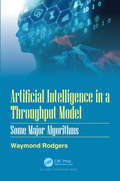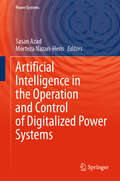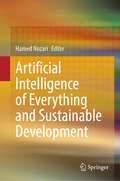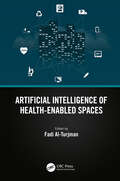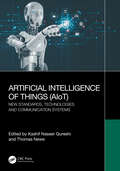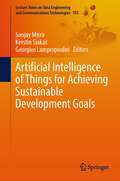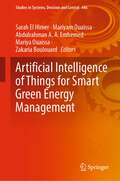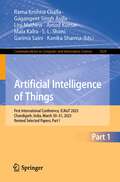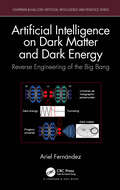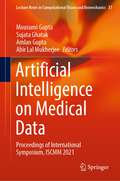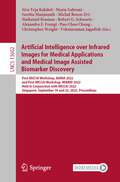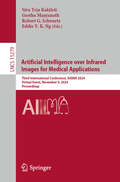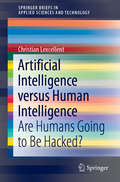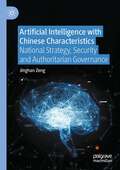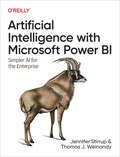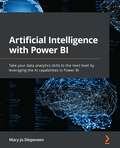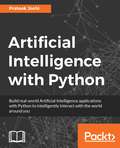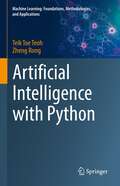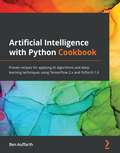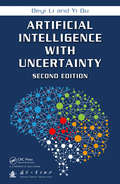- Table View
- List View
Artificial Intelligence in a Throughput Model: Some Major Algorithms
by Waymond RodgersPhysical and behavioral biometric technologies such as fingerprinting, facial recognition, voice identification, etc. have enhanced the level of security substantially in recent years. Governments and corporates have employed these technologies to achieve better customer satisfaction. However, biometrics faces major challenges in reducing criminal, terrorist activities and electronic frauds, especially in choosing appropriate decision-making algorithms. To face this challenge, new developments have been made, that amalgamate biometrics with artificial intelligence (AI) in decision-making modeling. Advanced software algorithms of AI, processing information offered by biometric technology, achieve better results. This has led to growth in the biometrics technology industry, and is set to increase the security and internal control operations manifold. This book provides an overview of the existing biometric technologies, decision-making algorithms and the growth opportunity in biometrics. The book proposes a throughput model, which draws on computer science, economics and psychology to model perceptual, informational sources, judgmental processes and decision choice algorithms. It reviews how biometrics might be applied to reduce risks to individuals and organizations, especially when dealing with digital-based media.
Artificial Intelligence in the Operation and Control of Digitalized Power Systems (Power Systems)
by Morteza Nazari-Heris Sasan AzadThis book covers the practical application of AI-based methods in modern power systems. The complexity of current power system operations has dramatically increased due to the higher penetration of renewable energy sources and power electronic components. Therefore, providing efficient techniques is essential for secure and clean power system operation. This book focuses on the data-driven operation of the digitalized power system using machine language (ML). First, the basics of power system operation and control are presented, covering various areas of system control and operation. Next, significant advances in modern power systems and their corresponding challenges are discussed, and artificial intelligence (AI)-powered techniques, specifically machine learning, are introduced to address these issues. The book also explores AI-powered applications in the operation of power systems. These applications include various aspects of the data-driven process in both situational awareness and control areas. They are presented as practical examples indicating the implementation of an ML-based method to solve operational problems. Artificial Intelligence in the Operation and Control of Digitalized Power Systems is a valuable guide for students, researchers, and practicing engineers to AI-based techniques and real-world applications in power systems.
Artificial Intelligence of Everything and Sustainable Development
by Hamed NozariThis book explores the intersection between transformative technologies and sustainable development. In today's world, characterized by diminishing energy sources, declining youth populations, and rapid technological advancements, the need for sustainable practices has never been more pressing. Technologies such as the Internet of Things (IoT), artificial intelligence (AI), blockchain, and hybrid technologies have not only revolutionized daily life but also presented new challenges and opportunities. The book presents the concept of "artificial intelligence of everything," highlighting the role of these technologies in driving sustainable, green, and futuristic development. It offers conceptual and quantitative frameworks to enhance understanding and presents insight into their application. Emphasizing the importance of looking beyond the present moment, the book advocates for a future-focused approach to technology, one that prioritizes sustainability in all endeavors. As the world navigates the complexities of the modern era, this book serves as a practical and essential guide. It is designed to help readers navigate the challenges of today's world and embrace sustainable practices that will shape a better future for all.
Artificial Intelligence of Health-Enabled Spaces
by Fadi Al-TurjmanArtificial Intelligence of Health-Enabled Spaces (AIoH) has made a number of revolutionary advances in clinical studies that we are aware of. Among these advances, intelligent and medical services are gaining a great deal of interest. Nowadays, AI-powered technologies are not only used in saving lives, but also in our daily life activities in diagnosing, controlling, and even tracking of COVID-19 patients. These AI-powered solutions are expected to communicate with cellular networks smoothly in the next-generation networks (5G/6G and beyond) for more effective/critical medical applications. This will open the door for other interesting research areas. This book focuses on the development and analysis of artificial intelligence (AI) model applications across multiple disciplines. AI-based deep learning models, fuzzy and hybrid intelligent systems, and intrinsic explainable models are also presented in this book. Some of the fields considered in this smart health-oriented book include AI applications in electrical engineering, biomedical engineering, environmental engineering, computer engineering, education, cyber security, chemistry, pharmacy, molecular biology, and tourism. This book is dedicated to addressing the major challenges in fighting diseases and psychological issues using AI. These challenges vary from cost and complexity to availability and accuracy. The aim of this book is hence to focus on both the design and implementation aspects of AI-based approaches in the proposed health-related solutions. Targeted readers are from varying disciplines who are interested in implementing the smart planet/environments vision via intelligent enabling technologies.
Artificial Intelligence of Things (AIoT): New Standards, Technologies and Communication Systems
by Kashif Naseer Qureshi Thomas NeweThis book is devoted to the new standards, technologies, and communication systems for Artificial Intelligence of Things (AIoT) networks. Smart and intelligent communication networks have gained significant attention due to the combination of AI and IoT networks to improve human and machine interfaces and enhance data processing and services. AIoT networks involve the collection of data from several devices and sensor nodes in the environment. AI can enhance these networks to make them faster, greener, smarter, and safer. Computer vision, language processing, and speech recognition are some examples of AIoT networks.Due to a large number of devices in today’s world, efficient and intelligent data processing is essential for problem-solving and decision-making. AI multiplies the value of these networks and promotes intelligence and learning capabilities, especially in homes, offices, and cities. However, several challenges have been observed in deploying AIoT networks, such as scalability, complexity, accuracy, and robustness. In addition, these networks are integrated with cloud, 5G networks, and blockchain methods for service provision. Many different solutions have been proposed to address issues related to machine and deep learning methods, ontology-based approaches, genetic algorithms, and fuzzy-based systems.This book aims to contribute to the state of the art and present current standards, technologies, and approaches for AIoT networks. This book focuses on existing solutions in AIoT network technologies, applications, services, standards, architectures, and security provisions. This book also introduces some new architectures and models for AIoT networks.
Artificial Intelligence of Things for Achieving Sustainable Development Goals (Lecture Notes on Data Engineering and Communications Technologies #192)
by Sanjay Misra Kerstin Siakas Georgios LampropoulosThis book covers various topics and trends regarding Artificial Intelligence (AI), Internet of Things (IoT), and their applications in society, industry, and environment for achieving Sustainable Development Goals (SDGs) suggested by the United Nations. Additionally, it discusses their advancements and fusion as well as the realization of Artificial Intelligence of Things (AIoT). The book aims to provide an overview and recent research into the fusion, integration, advancements, and impact of these technologies in the context of SDGs achievement. The topics include the applications of AI, IoT, big data, AI-based and IoT-based cloud computing, machine learning and deep learning techniques, and blockchain among others for achieving SDGs. It also presents findings and discussions on potential application domains, addresses open issues and challenges, offers solutions, and provides suggestions for future research for achieving SDGs. The chapters are clustered, according to particular SDGsor areas of focus, into: i) the realization of AIoT for SDGs, ii) the role of AIoT in achieving society and wellbeing-related SDGs, iii) the fulfillment of industrial sectors, infrastructure, and economy-related SDGs through AIoT, and iv) the use of AIoT to aid natural resources and environment-related SDGs. The book assists researchers, practitioners, professionals, and academicians of various scientific fields in exploring and better understanding these state-of-the-art technologies, their advancements, impact, future potentials and benefits, and their role in successfully achieving SDGs.The book:· Offers an in-depth overview of AIoT for achieving SDGs.· Presents the fusion of AI and IoT for bringing a significant change in everyday life and fulfilling SDGs.· Highlights innovative solutions and results of AIoT integration in several domains for achieving SDGs.· Showcases the influence of AIoT on promoting and improving sustainability in the context of SDGs.· Discusses the issues, benefits, solutions, and impact of AIoT in society, industry, and environment for achieving SDGs.
Artificial Intelligence of Things for Smart Green Energy Management (Studies in Systems, Decision and Control #446)
by Mariya Ouaissa Zakaria Boulouard Mariyam Ouaissa Sarah El Himer Abdulrahman A. A. EmhemedThis book is intended to assist in the development of smart and efficient green energy solutions. It introduces energy systems, power generation, and power demands which able to minimise generation costs, power loss or environmental effects. It proposes cutting-edge solutions and approaches based on recent technologies such as intelligent renewable energy systems (wind and solar). These solutions, applied to different sectors, can provide a solid basis for meeting the needs of both developed and developing countries. The book provides a collection of contributions including new techniques, methods, algorithms, practical solutions and models based on applying artificial intelligence and the Internet of things into green energy management systems. It provides a comprehensive reference for researchers, scholars and industry in the field of green energy and computational intelligence.
Artificial Intelligence of Things for Smarter Eco-Cities: Pioneering the Environmental Synergies of Urban Brain, Digital Twin, Metabolic Circularity, and Platform
by Simon Elias BibriThis book takes readers on a captivating journey into the transformative role of Artificial Intelligence (AI) and AI of Things (AIoT) technologies in reshaping sustainable urban development. By combining comprehensive theoretical analyses, synthesized empirical evidence, and practical case studies, it offers pioneering interdisciplinary insights and unifying frameworks. The book highlights the synergistic integration of Urban Brain (UB), Urban Digital Twin (UDT), Smart Urban Metabolism (SUM), and platform urbanism, underscored by their collaborative potential to revolutionize the environmental management, planning, and governance of smarter eco‑cities and sustainable smart cities. It leverages cutting‑edge technologies and data‑driven approaches to optimize urban systems, resource efficiency, and resilience. This approach provides a holistic understanding of the rapidly evolving landscape of AI‑ and AIoT‑driven sustainable urban development.Targeting a broad and diverse audience across multiple disciplines and fields, the book aims to share state‑of‑the‑art research, present innovative solutions, and forecast future trends in urban sustainability. As both a seminal reference and a valuable resource for researchers, practitioners, industry experts, and policymakers, it provides essential guidance for those engaged in driving technological innovation, steering urban transformation, promoting environmental sustainability, or working at the crossroads of these critical areas.
Artificial Intelligence of Things: First International Conference, ICAIoT 2023, Chandigarh, India, March 30–31, 2023, Revised Selected Papers, Part I (Communications in Computer and Information Science #1929)
by Kanika Sharma Mala Kalra Gagangeet Singh Aujla Rama Krishna Challa Lini Mathew Amod Kumar S. L. Shimi Garima SainiThese two volumes constitute the revised selected papers of First International Conference, ICAIoT 2023, held in Chandigarh, India, during March 30–31, 2023.The 47 full papers and the 10 short papers included in this volume were carefully reviewed and selected from 401 submissions. The two books focus on research issues, opportunities and challenges of AI and IoT applications. They present the most recent innovations, trends, and concerns as well as practical challenges encountered and solutions adopted in the fields of AI algorithms implementation in IoT Systems
Artificial Intelligence of Things: First International Conference, ICAIoT 2023, Chandigarh, India, March 30–31, 2023, Revised Selected Papers, Part II (Communications in Computer and Information Science #1930)
by Kanika Sharma Mala Kalra Gagangeet Singh Aujla Rama Krishna Challa Lini Mathew Amod Kumar S. L. Shimi Garima SainiThese two volumes constitute the revised selected papers of First International Conference, ICAIoT 2023, held in Chandigarh, India, during March 30–31, 2023.The 47 full papers and the 10 short papers included in this volume were carefully reviewed and selected from 401 submissions. The two books focus on research issues, opportunities and challenges of AI and IoT applications. They present the most recent innovations, trends, and concerns as well as practical challenges encountered and solutions adopted in the fields of AI algorithms implementation in IoT Systems
Artificial Intelligence on Dark Matter and Dark Energy: Reverse Engineering of the Big Bang (Chapman & Hall/CRC Artificial Intelligence and Robotics Series)
by Ariel FernándezAs we prod the cosmos at very large scales, basic tenets of physics seem to crumble under the weight of contradicting evidence. This book helps mitigate the crisis. It resorts to artificial intelligence (AI) for answers and describes the outcome of this quest in terms of an ur-universe, a quintessential compact multiply connected space that incorporates a fifth dimension to encode space-time as a latent manifold. In some ways, AI is bolder than humans because the huge corpus of knowledge, starting with the prodigious Standard Model (SM) of particle physics, poses almost no burden to its conjecture-framing processes. Why not feed AI with the SM enriched by the troubling cosmological phenomenology on dark matter and dark energy and see where AI takes us vis-à-vis reconciling the conflicting data with the laws of physics? This is precisely the intellectual adventure described in this book and – to the best of our knowledge – in no other book on the shelf. As the reader will discover, many AI conjectures and validations ultimately make a lot of sense, even if their boldness does not feel altogether "human" yet. This book is written for a broad readership. Prerequisites are minimal, but a background in college math/physics/computer science is desirable. This book does not merely describe what is known about dark matter and dark energy but also provides readers with intellectual tools to engage in a quest for the deepest cosmological mystery.
Artificial Intelligence on Medical Data: Proceedings of International Symposium, ISCMM 2021 (Lecture Notes in Computational Vision and Biomechanics #37)
by Mousumi Gupta Sujata Ghatak Amlan Gupta Abir Lal MukherjeeThis book includes high-quality papers presented at the Second International Symposium on Computer Vision and Machine Intelligence in Medical Image Analysis (ISCMM 2021), organized by Computer Applications Department, SMIT in collaboration with Department of Pathology, SMIMS, Sikkim, India, and funded by Indian Council of Medical Research, during 11 – 12 November 2021. It discusses common research problems and challenges in medical image analysis, such as deep learning methods. It also discusses how these theories can be applied to a broad range of application areas, including lung and chest x-ray, breast CAD, microscopy and pathology. The studies included mainly focus on the detection of events from biomedical signals.
Artificial Intelligence over Infrared Images for Medical Applications and Medical Image Assisted Biomarker Discovery: First MICCAI Workshop, AIIIMA 2022, and First MICCAI Workshop, MIABID 2022, Held in Conjunction with MICCAI 2022, Singapore, September 18 and 22, 2022, Proceedings (Lecture Notes in Computer Science #13602)
by Alejandro F. Frangi Robert G. Schwartz Geetha Manjunath Michal Rosen-Zvi Maria Gabrani Christopher Weight Siva Teja Kakileti Nathaniel Braman Pau-Choo Chung Vekataraman JagadishThis book constitutes the refereed proceedings of the First Workshop on Artificial Intelligence over Infrared Images for Medical Applications, AIIIMA 2022, and the First Workshop on Medical Image Assisted Biomarker Discovery, MIABID 2022, both held in conjunction with MICCAI 2022, Singapore, during September 18 and 22, 2022.For MIABID 2022, 7 papers from 10 submissions were accepted for publication. This workshop created a forum to discuss this specific sub-topic at MICCAI and promote this novel area of research among the research community that has the potential to hugely impact our society.For AIIIMA 2022, 10 papers from 15 submissions were accepted for publication. The first workshop on AIIIMA aimed to create a forum to discuss this specific sub-topic of AI over Infrared Images for Medical Applications at MICCAI and promote this novel area of research that has the potential to hugely impact our society, among the research community.
Artificial Intelligence over Infrared Images for Medical Applications: Third International Conference, AIIIMA 2024, Virtual Event, November 9, 2024, Proceedings (Lecture Notes in Computer Science #15279)
by Eddie Y. K. Ng Robert G. Schwartz Geetha Manjunath Siva Teja KakiletiThis book constitutes the refereed proceedings of the Third International Conference on Artificial Intelligence over Infrared Images for Medical Applications, AIIIMA 2024, held as a virtual event, on November 9, 2024. The 11 full papers presented in these proceedings were carefully reviewed and selected from 27 submissions. These papers focus on the application of Artificial Intelligence in medical infrared imaging for cancer screening, cancer diagnosis, cancer risk assessment, treatment monitoring, sports injury, diabetic foot ulcers detection, and pain management.
Artificial Intelligence versus Human Intelligence: Are Humans Going to Be Hacked? (SpringerBriefs in Applied Sciences and Technology)
by Christian LexcellentThis book showcases the fascinating but problematic relationship between human intelligence and artificial intelligence: AI is often discussed in the media, as if bodiless intelligence could exist, without a consciousness, without an unconscious, without thoughts. Using a wealth of anecdotes, data from academic literature, and original research, this short book examines in what circumstances robots can replace humans, and demonstrates that by operating beyond direct human control, strong artificial intelligence may pose serious problems, paving the way for all manner of extrapolations, for example implanting silicon chips in the brains of a privileged caste, and exposing the significant gap still present between the proponents of "singularity" and certain philosophers. With insights from mathematics, cognitive neuroscience and philosophy, it enables readers to understand and continue this open debate on AI, which presents concrete ethical problems for which meaningful answers are still in their infancy.
Artificial Intelligence with Chinese Characteristics: National Strategy, Security and Authoritarian Governance
by Jinghan Zeng“This book provides the first book-lengthy study focusing on Artificial Intelligence (AI) with Chinese characteristics, in line with China’s open ambition of becoming an AI superpower by 2030. China’s unique domestic politics has developed distinct characteristics for its AI approach. By analysing national strategy, security and governance aspects of AI in China, this book argues that China’s AI approach is sophisticated and multifaceted, and it has brought about both considerable benefits and challenges to China. First, many characterize China’s AI approach as a nationally concerted top-down geopolitical strategy to advance Beijing’s unified objective. This book argues that this view is mistaken. It shows that China’s AI politics is largely shaped by economically rather than geopolitically motivated domestic stakeholders. In addition, China’s national AI plan is an upgrade of existing local AI initiatives to the national level, reflecting a bottom-up development. Thus, China’s AI strategy is more of a political manifesto rather than a concrete policy plan. The second part of the book discusses how the Chinese central government has been securitizing AI in order to mobilize local states, market actors, intellectuals and the general public. This security discourse is built on China’s historical anxieties about technology, regime security needs and the growing tension caused by great power competition. Despite its help in convincing domestic actors, however, this securitization trend may undermine key AI objectives. The third part of the book studies the Chinese governance approach to the use of AI. It argues that China’s bold AI practices are part of its broad and incoherent adaptation strategy to governance by digital means. AI is part of a digital technology package that the Chinese authoritarian regime has actively employed not only to improve public services but also to strengthen its authoritarian governance. While China’s AI progress benefits from its unique political and social environment, its ambitious AI plan contains considerable risks. China’s approach is gambling on its success in (a) delivering a booming AI economy, (b) ensuring a smooth social transformation to the age of AI, and (c) proving ideological superiority of its authoritarian and communist values. This book suggests that a more accurate understanding of AI with Chinese characteristics is essential in order to inform the debate regarding what lessons can be learnt from China’s AI approach and how to respond to China’s rise as the AI leader if not superpower.”
Artificial Intelligence with Microsoft Power BI: Simpler AI for the Enterprise
by Jen Stirrup Thomas J. WeinandyAdvance your Power BI skills by adding AI to your repertoire at a practice level. With this practical book, business-oriented software engineers and developers will learn the terminologies, practices, and strategy necessary to successfully incorporate AI into your business intelligence estate. Jen Stirrup, CEO of AI and BI leadership consultancy Data Relish, and Thomas Weinandy, research economist at Upside, show you how to use data already available to your organization.Springboarding from the skills that you already possess, this book adds AI to your organization's technical capability and expertise with Microsoft Power BI. By using your conceptual knowledge of BI, you'll learn how to choose the right model for your AI work and identify its value and validity.Use Power BI to build a good data model for AIDemystify the AI terminology that you need to knowIdentify AI project roles, responsibilities, and teams for AIUse AI models, including supervised machine learning techniquesDevelop and train models in Azure ML for consumption in Power BIImprove your business AI maturity level with Power BIUse the AI feedback loop to help you get started with the next project
Artificial Intelligence with Power BI: Take your data analytics skills to the next level by leveraging the AI capabilities in Power BI
by Mary-Jo DiepeveenLearn how to create your own AI model and consume it in your Power BI reports to gain better insights from your dataKey FeaturesLearn how to gain better insights from your data by applying different AI techniques within Power BISave time by creating machine learning models independently and integrating them within your BI reportsUnderstand how to combine Cognitive Services and Azure Machine Learning together with Power BIBook DescriptionThe artificial intelligence (AI) capabilities in Power BI enable organizations to quickly and easily gain more intelligent insights from unstructured and structured data.This book will teach you how to make use of the many AI features available today in Power BI to quickly and easily enrich your data and gain better insights into patterns that can be found in your data.You'll begin by understanding the benefits of AI and how it can be used in Power BI. Next, you'll focus on exploring and preparing your data for building AI projects and then progress to using prominent AI features already available in Power BI, such as forecasting, anomaly detection, and Q&A. Later chapters will show you how to apply text analytics and computer vision within Power BI reports. This will help you create your own Q&A functionality in Power BI, which allows you to ask FAQs from another knowledge base and then integrate it with PowerApps. Toward the concluding chapters, you'll be able to create and deploy AutoML models trained in Azure ML and consume them in Power Query Editor. After your models have been trained, you'll work through principles such as privacy, fairness, and transparency to use AI responsibly.By the end of this book, you'll have learned when and how to enrich your data with AI using the out-of-the-box AI capabilities in Power BI.What you will learnApply techniques to mitigate bias and handle outliers in your dataPrepare time series data for forecasting in Power BIPrepare and shape your data for anomaly detectionUse text analytics in Power Query EditorIntegrate QnA Maker with PowerApps and create an appTrain your own models and identify the best one with AutoMLIntegrate an Azure ML workspace with Power BI and use endpoints to generate predictionsWho this book is forThis artificial intelligence BI book is for data analysts and BI developers who want to explore advanced analytics or artificial intelligence possibilities with their data. Prior knowledge of Power BI will help you get the most out of this book.
Artificial Intelligence with Python
by Prateek JoshiBuild real-world Artificial Intelligence applications with Python to intelligently interact with the world around you About This Book • Step into the amazing world of intelligent apps using this comprehensive guide • Enter the world of Artificial Intelligence, explore it, and create your own applications • Work through simple yet insightful examples that will get you up and running with Artificial Intelligence in no time Who This Book Is For This book is for Python developers who want to build real-world Artificial Intelligence applications. This book is friendly to Python beginners, but being familiar with Python would be useful to play around with the code. It will also be useful for experienced Python programmers who are looking to use Artificial Intelligence techniques in their existing technology stacks. What You Will Learn • Realize different classification and regression techniques • Understand the concept of clustering and how to use it to automatically segment data • See how to build an intelligent recommender system • Understand logic programming and how to use it • Build automatic speech recognition systems • Understand the basics of heuristic search and genetic programming • Develop games using Artificial Intelligence • Learn how reinforcement learning works • Discover how to build intelligent applications centered on images, text, and time series data • See how to use deep learning algorithms and build applications based on it In Detail Artificial Intelligence is becoming increasingly relevant in the modern world where everything is driven by technology and data. It is used extensively across many fields such as search engines, image recognition, robotics, finance, and so on. We will explore various real-world scenarios in this book and you'll learn about various algorithms that can be used to build Artificial Intelligence applications. During the course of this book, you will find out how to make informed decisions about what algorithms to use in a given context. Starting from the basics of Artificial Intelligence, you will learn how to develop various building blocks using different data mining techniques. You will see how to implement different algorithms to get the best possible results, and will understand how to apply them to real-world scenarios. If you want to add an intelligence layer to any application that's based on images, text, stock market, or some other form of data, this exciting book on Artificial Intelligence will definitely be your guide! Style and approach This highly practical book will show you how to implement Artificial Intelligence. The book provides multiple examples enabling you to create smart applications to meet the needs of your organization. In every chapter, we explain an algorithm, implement it, and then build a smart application.
Artificial Intelligence with Python (Machine Learning: Foundations, Methodologies, and Applications)
by Teik Toe Teoh Zheng RongEntering the field of artificial intelligence and data science can seem daunting to beginners with little to no prior background, especially those with no programming experience. The concepts used in self-driving cars and virtual assistants like Amazon’s Alexa may seem very complex and difficult to grasp. The aim of Artificial Intelligence in Python is to make AI accessible and easy to understand for people with little to no programming experience though practical exercises. Newcomers will gain the necessary knowledge on how to create such systems, which are capable of executing tasks that require some form of human-like intelligence. This book introduces readers to various topics and examples of programming in Python, as well as key concepts in artificial intelligence. Python programming skills will be imparted as we go along. Concepts and code snippets will be covered in a step-by-step manner, to guide and instill confidence in beginners. Complex subjects in deep learning and machine learning will be broken down into easy-to-digest content and examples. Artificial intelligence implementations will also be shared, allowing beginners to generate their own artificial intelligence algorithms for reinforcement learning, style transfer, chatbots, speech, and natural language processing.
Artificial Intelligence with Python Cookbook: Proven recipes for applying AI algorithms and deep learning techniques using TensorFlow 2.x and PyTorch 1.6
by Ben AuffarthWork through practical recipes to learn how to solve complex machine learning and deep learning problems using PythonKey FeaturesGet up and running with artificial intelligence in no time using hands-on problem-solving recipesExplore popular Python libraries and tools to build AI solutions for images, text, sounds, and imagesImplement NLP, reinforcement learning, deep learning, GANs, Monte-Carlo tree search, and much moreBook DescriptionArtificial intelligence (AI) plays an integral role in automating problem-solving. This involves predicting and classifying data and training agents to execute tasks successfully. This book will teach you how to solve complex problems with the help of independent and insightful recipes ranging from the essentials to advanced methods that have just come out of research.Artificial Intelligence with Python Cookbook starts by showing you how to set up your Python environment and taking you through the fundamentals of data exploration. Moving ahead, you'll be able to implement heuristic search techniques and genetic algorithms. In addition to this, you'll apply probabilistic models, constraint optimization, and reinforcement learning. As you advance through the book, you'll build deep learning models for text, images, video, and audio, and then delve into algorithmic bias, style transfer, music generation, and AI use cases in the healthcare and insurance industries. Throughout the book, you'll learn about a variety of tools for problem-solving and gain the knowledge needed to effectively approach complex problems.By the end of this book on AI, you will have the skills you need to write AI and machine learning algorithms, test them, and deploy them for production.What you will learnImplement data preprocessing steps and optimize model hyperparametersDelve into representational learning with adversarial autoencodersUse active learning, recommenders, knowledge embedding, and SAT solversGet to grips with probabilistic modeling with TensorFlow probabilityRun object detection, text-to-speech conversion, and text and music generationApply swarm algorithms, multi-agent systems, and graph networksGo from proof of concept to production by deploying models as microservicesUnderstand how to use modern AI in practiceWho this book is forThis AI machine learning book is for Python developers, data scientists, machine learning engineers, and deep learning practitioners who want to learn how to build artificial intelligence solutions with easy-to-follow recipes. You'll also find this book useful if you're looking for state-of-the-art solutions to perform different machine learning tasks in various use cases. Basic working knowledge of the Python programming language and machine learning concepts will help you to work with code effectively in this book.
Artificial Intelligence with Python: Your complete guide to building intelligent apps using Python 3.x and TensorFlow 2, 2nd Edition
by Prateek Joshi Alberto ArtasanchezNew edition of the bestselling guide to artificial intelligence with Python, updated to Python 3.x and TensorFlow 2, with seven new chapters that cover RNNs, AI & Big Data, fundamental use cases, chatbots, and more. Key Features Completely updated and revised to Python 3.x, and TensorFlow 2 Seven new chapters that include AI on the cloud, RNNs and DL models, feature engineering, the machine learning data pipeline, and more New author with 25 years of experience in artificial intelligence across multiple industries and enterprise domains Book Description Artificial Intelligence with Python, Second Edition is an updated and expanded version of the bestselling guide to artificial intelligence using the latest version of Python 3.x and TensorFlow 2. Not only does it provide you an introduction to artificial intelligence, this new edition goes further by giving you the tools you need to explore the amazing world of intelligent apps and create your own applications. This edition also includes seven new chapters on more advanced concepts of Artificial Intelligence, including fundamental use cases of AI; machine learning data pipelines; feature selection and feature engineering; AI on the cloud; the basics of chatbots; RNNs and DL models; and AI and Big Data. Finally, this new edition explores various real-world scenarios and teaches you how to apply relevant AI algorithms to a wide swath of problems, starting with the most basic AI concepts and progressively building from there to solve more difficult challenges so that by the end, you will have gained a solid understanding of, and when best to use, these many artificial intelligence techniques. What you will learn Understand what artificial intelligence, machine learning, and data science are Explore the most common artificial intelligence use cases Learn how to build a machine learning pipeline Assimilate the basics of feature selection and feature engineering Identify the differences between supervised and unsupervised learning Discover the most recent advances and tools offered for AI development in the cloud Develop automatic speech recognition systems and chatbots Understand RNNs and various DL models Who this book is for The intended audience for this book is Python developers who want to build real-world Artificial Intelligence applications. Basic Python programming experience and awareness of machine learning concepts and techniques is mandatory.
Artificial Intelligence with Uncertainty
by Yi Du Deyi LiThis book develops a framework that shows how uncertainty in Artificial Intelligence (AI) expands and generalizes traditional AI. It explores the uncertainties of knowledge and intelligence. The authors focus on the importance of natural language – the carrier of knowledge and intelligence, and introduce efficient physical methods for data mining amd control. In this new edition, we have more in-depth description of the models and methods, of which the mathematical properties are proved strictly which make these theories and methods more complete. The authors also highlight their latest research results.
Artificial Intelligence with Uncertainty
by Deyi Li Yi DuThe information deluge currently assaulting us in the 21st century is having a profound impact on our lifestyles and how we work. We must constantly separate trustworthy and required information from the massive amount of data we encounter each day. Through mathematical theories, models, and experimental computations, Artificial Intelligence with U
Artificial Intelligence with and for Learning Sciences. Past, Present, and Future Horizons: First Workshop, WAILS 2024, Salerno, Italy, January 18-19, 2024, Proceedings (Lecture Notes in Computer Science #14545)
by Fabio Palomba Carmine GravinoThis book constitutes the refereed conference proceedings of the First Workshop on Artificial Intelligence with and for Learning Sciences - Past, Present, and Future Horizons, WAILS 2024, held in Salerno, Italy, during January 18-19, 2024. The 14 full papers and 5 short papers presented in this book were carefully reviewed. The contributions present and discuss previous achievements, current challenges and solutions, and future perspectives concerned with the adoption of artificial intelligence methods and techniques in the context of learning sciences.
